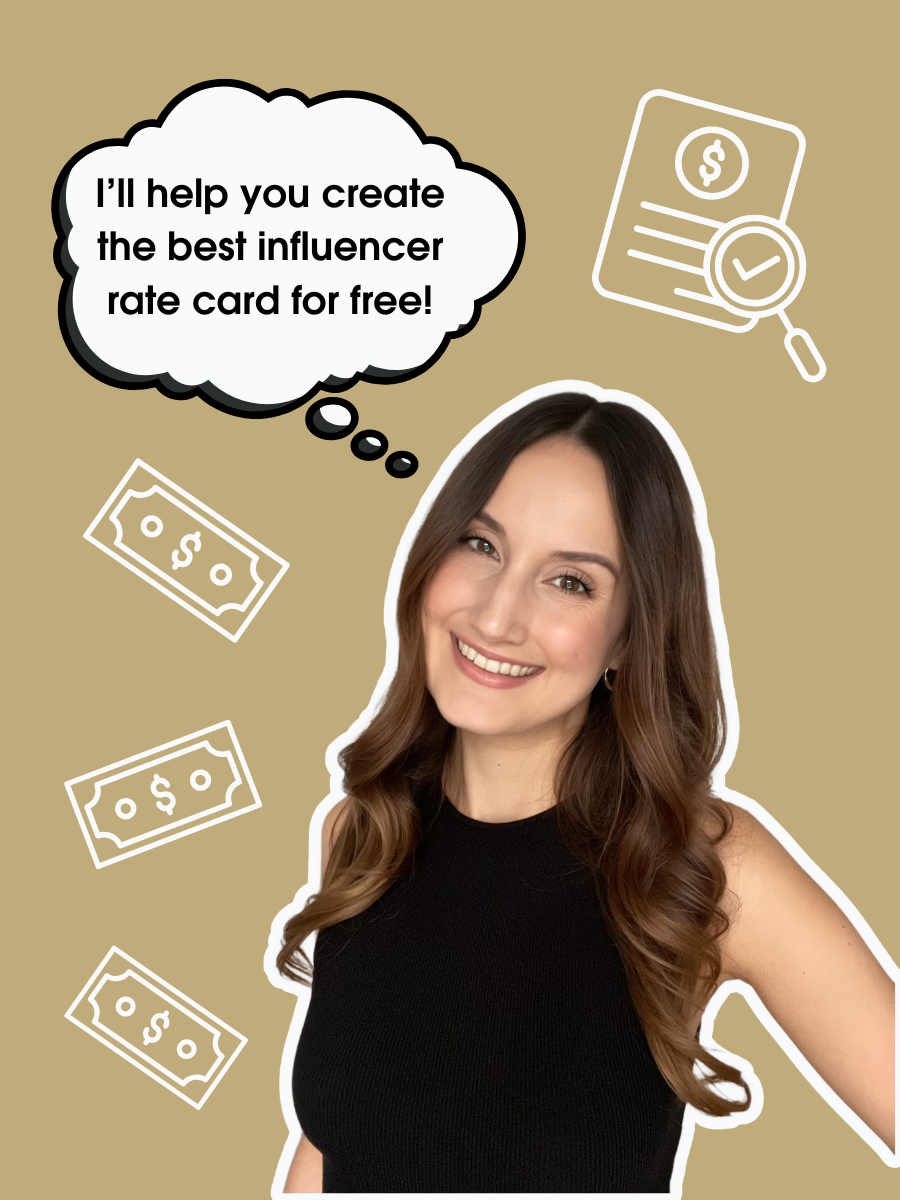11 Essential Rates Every Influencer Rate Card Must Have (to 5x Your Brand Deals) + FREE Template
Do you need an influencer rate card that gets brands to say “yes” — and pay more? An influencer rate card isn’t just a price list. When done right, it’s a strategic sales tool that can 5x your income from brand deals.
As a lawyer for influencers and creators, I’ve reviewed and created countless influencer rate cards — and I’ve seen firsthand what works, what kills a deal, and which rates will make brands open their wallets.
In this post, I’m breaking down the 11 essential rates every influencer rate card needs to protect your time, boost your profits, and make negotiations smoother. Whether you’re on Instagram, TikTok, or YouTube, you’ll learn exactly how to structure your rates so you’re charging what you’re worth — and getting it.
And because I don’t want you to waste hours designing one from scratch, you’ll also get my ready-to-use Canva influencer rate card template — free. You can use it as a TikTok, YouTube, or Instagram influencer rate card! Just plug in your own rates, send it to brands, and start earning more.
This post is all about the 11 must-have rates every influencer rate card should include to maximise your brand deals (and safeguard your value).
Ultimate Influencer Rate Card
Access Your Free Influencer Rate Card Canva Template Now!
💌 Want a ready-made influencer rate card template?
Don’t start from scratch. Get my FREE influencer rate card Canva template — pre-formatted with all the key rates in this guide. Just fill in your numbers, save as a PDF, and send it to brands.
Now, let’s dive into each of the 11 rates for your influencer rate card!
The 11 Key Rates for Your Influencer Rate Card Template
1. Base Rates for Each Platform & Post Type
Your base rate is the foundation of your influencer rate card — and every other fee you charge builds on it. Without a clear base rate, you risk getting lowballed or having brands expect multiple deliverables for the price of one.
In your rate card, list a separate base rate for:
Each platform you create sponsored content for (Instagram, TikTok, YouTube, etc.)
Each content format you offer (Reel, Story, Carousel, Static Post, Long-Form Video, Short, etc.)
💡 Pro Tip: Consider splitting your base rates into Dedicated and Integrated posts:
Dedicated = the entire post focuses on the brand’s product or service.
Integrated = the brand is featured naturally within a broader topic.
By being this specific, you set clear expectations, make negotiations easier, and prevent scope creep.
2. Package Deal Rates
Package deals (or bundles) are one of the easiest ways to increase the size of a brand deal without dramatically increasing your workload. Instead of a brand booking you for just one post, you offer a package of content at a slightly discounted total rate — making it a better deal for them, and a higher overall paycheck for you.
Two main types of package deals:
Same-platform bundles:
Example — on Instagram:1 Reel + 1 Story + 1 Static Post
Instead of pricing each separately at full price, you might offer the bundle at 10–20% less than the sum of individual rates.
Cross-platform bundles:
Example — 1 YouTube video + 1 TikTok video + 1 Instagram Reel
This allows the brand to get exposure across multiple audiences in one go.
💡 Pro Tip: You can also create campaign packages, which are bundles spread over time. For example:
6 sponsored Reels over 3 months (1 Reel every 2 weeks)
3 YouTube integrations over 3 months (1 video per month)
I also discuss discounted package deals in more detail in this blog post on the 23 Best Ways to Make Money as a Photographer in Any Niche to Maximise Income.
3. Organic Usage Rights Rate
Organic usage rights give a brand permission to repost your sponsored content on their own social channels or website — without paying for ads to boost it.
How to price it:
Charge a separate fee for organic usage rights based on a fixed period (e.g., 30 days or 3 months).
If the brand wants to keep using the content after that period, charge an additional fee per extra 30 days — either a fixed amount or a % of your base rate.
Example: Organic usage rights = 20% of your base rate per 30 days. If your Reel is $1,000 and the brand wants 3 months, that’s $600 extra (20% × $1,000 × 3).
💡 Tip 1: Some influencers include 30 days or 3 months of organic usage rights in their base rate. I recommend charging separately — it’s extra value for the brand, and you should be compensated for it.
💡 Tip 2: Always specify the time period in writing — otherwise, a brand could keep using your content forever without paying more. My Brand Sponsorship Contract includes clear usage rights clauses so you’re legally protected.
4. Paid Usage Rights Rate
Paid usage rights allow a brand to use your content for advertising — such as Facebook ads, Instagram ads, YouTube pre-rolls, Google ads, or in email marketing campaigns. This is far more valuable to the brand than organic usage because it’s part of their paid marketing strategy.
How to price it:
Charge for paid usage rights separately from organic usage rights.
Price them based on:
A fixed fee or % of your base rate for every 30 days (or longer period).
For larger influencers, a % of the ad spend is common.
Example: Paid usage rights = 30% of your base rate per 30 days. If your TikTok is $1,500 and the brand wants to run it as an ad for 2 months, that’s $900 extra (30% × $1,500 × 2).
💡 Tip: Paid usage rights should never be open-ended. Specify the exact usage period and platforms in your contract to avoid your content being used in paid ads years later without compensation. My Brand Sponsorship Contract includes ironclad clauses for this.
5. Whitelisting Rate
Whitelisting allows a brand to run ads from your social media account — so the ad appears under your name and profile, but is paid for and targeted by the brand.
Brands may pitch this as “extra exposure” for you, but whitelisting can lower your engagement rate and change how your audience sees your content. That’s why it should always come with a separate fee.
How to price it:
Fixed fee or % of your base rate per 30 days (or longer).
Larger influencers may charge a % of the ad spend.
Example: If your Instagram Reel is $1,200 and your whitelisting fee is 25% per 30 days, a 2-month whitelisting period would add $600 (25% × $1,200 × 2).
💡 Pro Tip: Want all 11 rates pre-formatted and ready to send to brands? Download my free Canva influencer rate card template by subscribing to my newsletter below — it’s fully customisable and ready to use.
6. Exclusivity Rate
Exclusivity means you agree not to work with competing brands for a certain period after the sponsored post goes live. For example, if you promote a skincare brand, you might be restricted from working with any other skincare brands for 30, 60, or even 90 days.
While this can be valuable to the brand, it limits your earning potential — so you should always charge extra for exclusivity.
How to price it:
Set the rate as a % of your base rate per 30 days of exclusivity.
The longer the restriction or the broader the category, the higher your fee should be.
Example: Your base fee for a YouTube integration is $2,000. The brand requests 60 days of exclusivity in the same product category, at 30% per 30 days. That’s $1,200 extra (30% × $2,000 × 2).
💡 Tip: Clearly define the limits of your exlcusivity and what a “competitor” is in your contract to avoid misunderstandings — a vague definition can block you from working with unrelated brands. My Brand Sponsorship Contract includes a precise exclusivity clause to protect your future deals.
7. Link in Bio Rate
A “link in bio” rate is an extra fee you charge when a brand wants their product link placed in your profile bio for a set period. Your bio is prime advertising space — it’s visible to everyone visiting your profile and can drive significant clicks.
How to price it:
Set a fixed fee or a % of your base rate for a defined time frame (e.g., 30 days).
Longer periods = higher fees.
Example: If your base rate for an Instagram Reel is $1,000 and you charge 15% per 30 days for a link in bio, a 2-month placement would be $300 extra (15% × $1,000 × 2).
💡 Tip: Include the start and end dates in writing to avoid a brand expecting permanent placement. My Brand Sponsorship Contract covers link placements, so brands can’t overstay their agreed time.
8. Additional Revision Rate
Your base rate should always include a set number of revision rounds (e.g., one or two). Anything beyond that should be charged as an additional revision fee — otherwise, you risk spending endless hours re-editing without extra pay.
How to price it:
Charge a fixed fee per extra round, or
A % of your base rate for larger projects.
Example: Your TikTok video rate is $1,000 and you include 1 revision in the base price. If you charge 10% per extra revision and the brand requests 2 more, that’s $200 extra (10% × $1,000 × 2).
💡 Tip: Always state how many revisions are included in your rate card and what counts as a revision (minor vs. major changes). My Brand Sponsorship Contract spells this out so there’s no confusion — and no unpaid extra work.
9. Post-Production Editing Rate
Post-production editing fees apply when a brand wants changes after the sponsored content has already been delivered and approved — often so they can repurpose it for other uses.
Unlike a revision (which happens before approval), post-production edits take extra time and should be charged separately. This is especially important if your contract states that only you can make edits to your content — protecting your brand image and creative integrity.
How to price it:
Charge a fixed fee per edit request, or
A % of your base rate for larger changes.
Example: Your Instagram Reel is $1,200. If you charge 15% for a post-production edit, a single change request would cost $180 extra.
💡 Tip: Specify in your contract that the brand cannot edit your content themselves without your approval. My Brand Sponsorship Contract includes strong editing rights clauses so you stay in control.
10. Giveaway Rate
Hosting a giveaway for a brand can be a great engagement booster — but it’s also a lot of work. You’re handling the promotion, entries, winner selection, and often communication with participants.
How to price it:
Charge a fixed fee or a % of your base rate for the extra time and effort.
The more complex the giveaway (e.g., multiple prizes, multi-step entries), the higher your fee should be.
Example: Your TikTok video is $800, and you charge 20% for hosting a giveaway in connection with that post. That’s $160 extra.
11. Rush Fee
A rush fee is an extra charge for expedited content creation and posting. Brands often come to you with last-minute requests due to tight campaign deadlines — but delivering fast means rearranging your schedule, prioritising their project, and potentially delaying other work.
How to price it:
Charge a % of your base rate (commonly 20–50%) for urgent turnarounds.
The shorter the deadline, the higher your fee should be.
Example: Your Instagram Reel rate is $1,000, and the brand needs it in 48 hours instead of your usual 7 days. If your rush fee is 30%, you’d add $300 to the total.
💡 Tip: Define “rush” in your contract (e.g., any delivery in less than 5 business days) so there’s no confusion. My Brand Sponsorship Contract has this built in to prevent unrealistic deadlines without extra pay.
Grab Your FREE Influencer Rate Card Canva Template!
Now you know the 11 essential rates every influencer rate card should include to protect your time, increase your earnings, and make negotiations smoother.
When you list your rates clearly — and price every extra service separately — you not only set boundaries but also maximise your income from every brand deal.
The next step? Put it all into a polished, professional rate card that’s ready to send to brands. And you don’t need to start from scratch…
🎁 Download My FREE Influencer Rate Card Canva Template
Skip the design work and get my ready-to-use influencer rate card template. Just plug in your own rates, save it as a PDF, and start pitching brands today.
You’ll also get access to my entire free legal and business resource library, including checklists, templates, and guides for creators.
💡 Once you’ve got your rate card ready, make sure your deals are locked in with a solid agreement. My Brand Sponsorship Contract includes all the clauses you need to protect your content, usage rights, and payment terms.
Influencer Rate Card Calculator
Don’t know how much you should be charging brands?
I’ve written an entire blog post on how to calculate your base rate, and I’ve included a simple influencer rate card calculator to help you calculate your own rate.
Just go to my blog post on How Much Should I Charge as an Influencer in 2025? 15 Crucial Factors (+ Example Calculation).
Optimize Your Instagram Influencer Rate Card to 5x Your Brand Deals
Are you an Instagram influencer?
I have written a blog post specifically on the add-on rates you should include in an Instagram influencer rate card for sponsored Instagram posts. With these add-ons, you’ll easily 3x your brand deals! And I back it up with an example influencer rate card calculator.
Find out how to 3x your Instagram sponsorships in this blog post on the 5+ Key Add-Ons for Your Instagram Post Price List to 3x Your Brand Deals (+ Example Calculation).
This post was all about the important rates to include in your influencer rate card to maximise your brand deals (and safeguard your value).
Other blog posts you may like:




